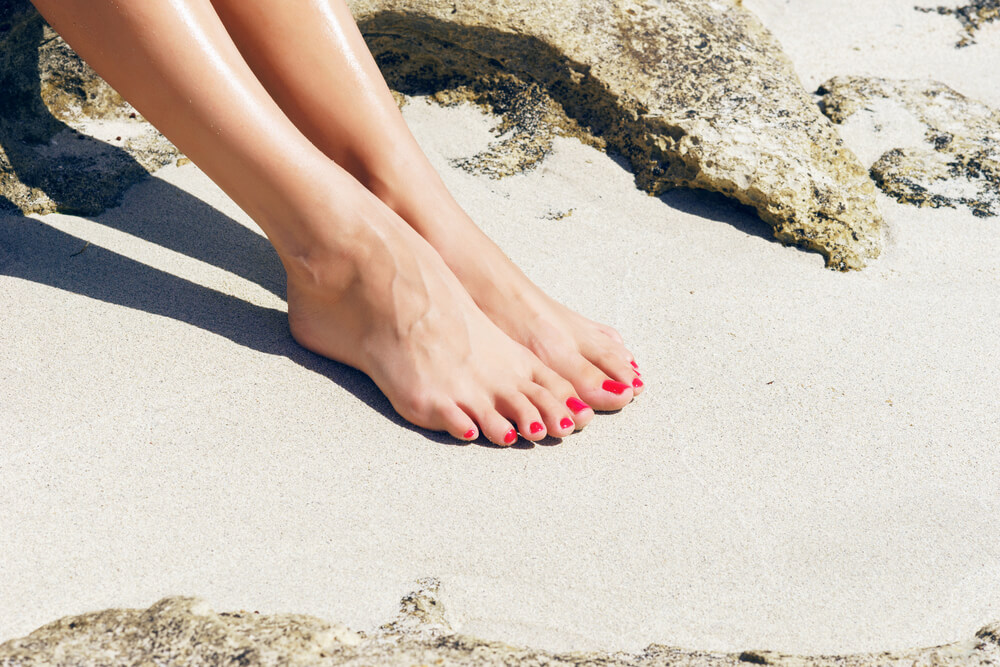When the temperatures warm up, we all like to free our feet from socks and closed shoes. However, this is not always a pretty sight, for example, thickened areas on the nails, curvatures of the nail plate or twists on the nail become visible.
But how can this happen and are there any treatment options? Find out more about: Symptoms and treatment tips for nail changes in the following tips from our expert.
Changes to the nail bed and nail plate
Let us first look at the changes in the nail bed with a solid horny substance (a so-called pachyonychia). The nail plate itself is thin in this case. According to expert Anke Niederau, the causes are very easy to define:
The changes can often be hereditary, or pressure or impact caused by too tight and incorrect footwear can be the reason for these changes. What can be done? The nail itself should not be cut, as the nail is very thin. Instead, the callus must be carefully removed. Only then can nail prosthetics be started, and wide shoes, foot exercises and orthoses are recommended to support this.
Pachyonychia is often indistinguishable from onychogryposis at first glance. This is a claw-like thickening, curvature or twisting of the nail. This means that it is not the cornea but the nail itself that forms the thickenings. However, a callus is often also visible on the underside of the nail deformities. The nail is often discolored and barely adheres to the nail bed. Instead, the nail grows upwards. This is often caused by a lack of care, but there may also be health reasons.
The recommended treatment is to remove or mill off the nail areas that grow beyond the edge of the toe. This is done step by step, down to a normal nail thickness. However, such nails are often brittle or even mycotic, i.e. a fungus is involved. In the case of a nail fungus, for example, special care must therefore be taken and the affected areas must be treated preventively or directly, e.g. with antibacterial and antiviral agents.
Treatment and tips for dealing with nail thickening
Nail thickenings are often also referred to as wooden nails. The name is based on the nature of the nails. In this case, they are hard like wood and also visually resemble it; so-called grypothic nails.
Not just unattractive. In fact, clarification by an expert is crucial here. The symptoms: The nail loses its transparency, shape and flexibility. Wooden nails often also appear with a fungal infection (athlete’s foot or nail fungus). Here too, it is important to gradually remove these excess areas and reduce the pressure or possible friction on these areas. But always pay attention to possible mycoses. Hygiene is crucial and incredibly important. This is especially true for people with diabetes.
What to do if nail deformation occurs?
One form of nail deformation that is comparatively easy to treat, on the other hand, is ingrown nails (known as unguis incarnatus). This is often caused by shoes that are too tight or an incorrect nail cut, where the nail is shortened too deeply. The nail grows into the surrounding tissue, where it can lead to inflammation. Nail correction braces can then help to slowly lift the nail again without detaching it from the nail bed. The right shoes and socks are also helpful. Here too, as with all of the above measures, it is strongly recommended that you consult an expert and have it professionally treated.
If you have unsightly nails, it’s only natural to embellish them with color or nail polish. But be careful! Conventional, non-breathable polishes can exacerbate nail problems! In the case of nail fungus in particular, a sealed-off atmosphere under the nail acts like a kind of greenhouse. In this case, the fungus can spread unhindered underneath. In such cases, therefore, only a breathable nail polish should be used.
Questions for our experts? Then send us a message to info@ocean-pharma.de, our experts will be happy to help you. Further helpful tips and advice, in addition to the article: Symptoms and treatment tips for nail changes, can also be found in our expert tips on ocean-pharma.de.
Image source: Maksim Shmeljov / shutterstock.com
Experten-Tipp entstand in Zusammenarbeit mit:

Anke Niederau
Anke Niederau has been self-employed in medical foot care since 1990. Among other things, she has completed further training on the subject of "reflexology work on the foot" and as a diabetic podiatrist DDG. She is also the author of the bestseller "Das große Buch der Nagelerkrankungen".
Until 2005, she worked as a lecturer in medical foot care at the Düsseldorf Chamber of Crafts and until 2006 as a teacher at the Kaiserswerther Diakonie specialist school for podiatry. Since 2007, the author has worked as a freelance lecturer at various podiatry and chiropody schools.




